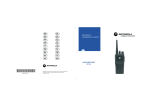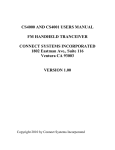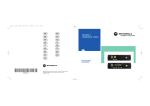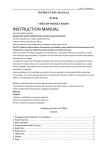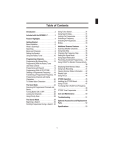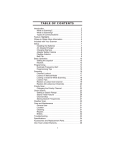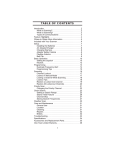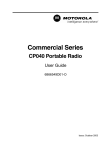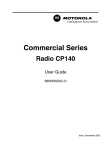Download Motorola CP160 User guide
Transcript
Commercial Series Radio CP160 User Guide 6866550D05-O Issue: December 2003 9 10 11 1 P1 P2 8 7 6 5 4 3 2 12 13 Computer Software Copyrights . . . . . . . . . 2 Radio Overview . . . . . . . . . . . . . . . . . . . . 3 Operation and Control Functions . . . . . . . . 3 Radio Controls . . . . . . . . . . . . . . . . . . . 3 Programmable Buttons . . . . . . . . . . . . . 4 Indicator Tones . . . . . . . . . . . . . . . . . . . 8 Battery Charge Status. . . . . . . . . . . . . . 9 LED Indicator . . . . . . . . . . . . . . . . . . . . 9 LCD Display and Icons . . . . . . . . . . . . 10 Menu Buttons . . . . . . . . . . . . . . . . . . . 11 Menu Navigation Chart . . . . . . . . . . . . 12 Getting Started . . . . . . . . . . . . . . . . . . . . 13 Battery Information. . . . . . . . . . . . . . . . . . Charging Your Battery. . . . . . . . . . . . . Desktop Rapid Charger. . . . . . . . . . . . Accessory Information . . . . . . . . . . . . . . . Attaching the Battery. . . . . . . . . . . . . . Removing The Battery . . . . . . . . . . . . Attaching The Antenna . . . . . . . . . . . . Removing The Antenna . . . . . . . . . . . Attaching The Belt Clip . . . . . . . . . . . . Removing The Belt Clip . . . . . . . . . . . 13 13 14 15 15 15 16 16 17 17 Turning the Radio On or Off . . . . . . . . . . .18 Radio On Message . . . . . . . . . . . . . . . . . .18 Adjusting the Volume. . . . . . . . . . . . . . . . .18 Selecting a Radio Channel . . . . . . . . . . . .19 Home Revert Memory Channel (1&2) . . . .19 Store Memory Channel (1&2) . . . . . . . . . .19 Receiving a Call. . . . . . . . . . . . . . . . . . . . .20 Sending a Call . . . . . . . . . . . . . . . . . . . . . .20 Monitoring . . . . . . . . . . . . . . . . . . . . . . . . .21 VOX Operation . . . . . . . . . . . . . . . . . . . . .21 Connecting a VOX Headset . . . . . . . . .21 Enable/Disable Headset Sidetone. . . . . . .22 VOX Headset . . . . . . . . . . . . . . . . . . . .22 Non-VOX Headset With In-Line PTT . .22 Keypad Lock/Unlock . . . . . . . . . . . . . . . . .22 Radio Calls . . . . . . . . . . . . . . . . . . . . . . . .23 Receiving a Selective Call . . . . . . . . . . . . .23 Sending a Selective Call . . . . . . . . . . . . . .23 Receiving a Call Alert Page . . . . . . . . . . . .24 Sending a Call Alert Page . . . . . . . . . . . . .24 Repeater Or Talkaround Mode . . . . . . . . .25 1 English CONTENTS CONTENTS CONTENTS Scan. . . . . . . . . . . . . . . . . . . . . . . . . . . . . Start System Scan . . . . . . . . . . . . . . . . . . Stop System Scan . . . . . . . . . . . . . . . . . . Start Auto Scan . . . . . . . . . . . . . . . . . . . . Stop Auto Scan . . . . . . . . . . . . . . . . . . . . Talkback. . . . . . . . . . . . . . . . . . . . . . . . . . Delete a Nuisance Channel . . . . . . . . . . . Restore Channels to the Scan List . . . Edit a Scan List . . . . . . . . . . . . . . . . . . . . Add or Delete Channels . . . . . . . . . . . . . . Prioritize a Channel in a Scan List . . . . . . Set Priority Channels . . . . . . . . . . . . . 27 27 28 28 28 28 29 29 29 30 31 31 Phone . . . . . . . . . . . . . . . . . . . . . . . . . . . Access the Repeater . . . . . . . . . . . . . . . . Receive a Phone Call. . . . . . . . . . . . . . . . Disconnect a Phone Call . . . . . . . . . . . . . Make a Phone Call. . . . . . . . . . . . . . . . . . 33 33 33 34 34 Tone Preferences . . . . . . . . . . . . . . . . . . Tones On/Off . . . . . . . . . . . . . . . . . . . . . . Keypad On/Off Tones . . . . . . . . . . . . . . . Call Tone Tagging . . . . . . . . . . . . . . . . . . Escalert . . . . . . . . . . . . . . . . . . . . . . . . . . 35 37 37 38 38 English 2 User Settings . . . . . . . . . . . . . . . . . . . . . .39 Set Squelch Level . . . . . . . . . . . . . . . . . . .41 Set Power Level . . . . . . . . . . . . . . . . . . . .41 Option Board On/Off . . . . . . . . . . . . . . . . .42 Set the Lights. . . . . . . . . . . . . . . . . . . . . . .42 Display the Software Version . . . . . . . . . .43 Computer Software Copyright The products described in this manual may include copyrighted computer programmes stored in semiconductor memories or other media. Laws in the United States of America and other countries preserve for Motorola Europe and Motorola Inc. certain exclusive rights for copyrighted computer programmes, including the right to copy or reproduce in any form the copyrighted computer programme. Accordingly, any copyrighted computer programmes contained in the products described in this manual may not be copied or reproduced in any manner without the express written permission of the holders of the rights. Furthermore, the purchase of these products shall not be deemed to grant either directly or by implication, estoppel, or otherwise, any licence under the copyrights, patents, or patent applications of the holders of the rights, except for the normal non-exclusive royalty free licence to use that arises by operation of the law in the sale of the product. This user guide covers the operation of the CP160 Portable Radios. Before using this product, read the operating instructions for safe usage contained in the Product Safety and RF Exposure booklet 6864117B25_ C a u t i o n enclosed with your radio. ! ATTENTION! This radio is restricted to occupational use only to satisfy ICNIRP RF energy exposure requirements. Before using this product, read the RF energy awareness information and operating instructions in the Product Safety and RF Exposure booklet (Motorola Publication part number 6864117B25_) to ensure compliance with RF energy exposure limits. OPERATION AND CONTROL FUNCTIONS Radio Controls The numbers below refer to the illustrations on the inside front cover. 1. 2. Push-to-talk (PTT) Press and hold down this button to talk; release it to listen. On-Off / Volume Knob Used to turn the radio on or off, and to adjust the radio’s volume. 3. Channel Selector Knob Used to switch the radio to different channels. 4. LED Indicators Indicate radio status: Green: Solid during power up routine; off after successful power up; flashing when scanning. Red: Solid - transmitting; Flashing when transmitting - low battery: Flashing - channel is busy receiving. Yellow: Solid when radio is in monitor mode,or is sending a selective call or call alert; Flashing - receiving a selective call or call alert. 5. Microphone/Speaker Hold the microphone 2.5 to 5 cm (1-2 inches) from your mouth, and speak clearly into it. 6. LCD Display An 8 character single line display with up to 9 radio status icons. 7. Front Button P2 J 8. Menu Scroll Buttons L M 9. Front Button P1 K 10. Side Button 2 11. Side Button 1 12. Accessory Connector Connects remote microphones, remote earphones and other accessories. Replace dust cap when not in use. 13. Belt Clip 3 English RADIO OVERVIEW RADIO OVERVIEW Programmable Buttons RADIO OVERVIEW Your radio has four programmable buttons. Your dealer can program these buttons as shortcuts to various radio features. Check with your dealer for a complete list of functions your radio supports. Programmable buttons include: • Side Buttons (S1 and S2) • Front Buttons (K and J) Some buttons can access up to two features, depending on the type of button press: • short press—quickly pressing and releasing the programmable buttons • long press—pressing and holding the programmable buttons for a minimum of 2.5 seconds • hold down—pressing and holding down the programmable buttons while checking status or making adjustments English 4 The following table is a summary of programmable radio features and corresponding page references. In the “Button” column, have your dealer record the name of the programmable button next to the feature that has been programmed to it. Also, where appropriate, have your dealer indicate whether the button press requires a short press, a long press, or needs to be held down. Indicator Battery Indicator Menu Mode — Volume Set — Home Revert Memory Channel (1&2) — Store Memory Channel (1&2) — Monitor † C Short Press Long Press — — Hold Down Checks the battery charge status. J button enters Menu Mode and selects menu options. Once in Menu Mode, K button is automaticall re-assigned to exit Menu Mode.† — Allows instant access to the home channel. Page Button 9 — 11 — Sounds a tone for adjusting the radio’s volume level. 18 — — 19 — 19 Stores current channel to the home channel. A long press initiates Monitor. A short press cancels Monitor. Monitors the selected channel for any activity. J 21 This function is activated by EITHER a short OR a long press, but not both. 5 English RADIO OVERVIEW Feature RADIO OVERVIEW Feature Indicator Short Press Long Press Hold Down Voice Operated Transmission (VOX) — Keypad Lock/ Unlock L Radio Call — Directly access radio call menu.† — 23 Repeater/ Talkaround J Toggles between using a repeater or transmitting directly to another radio.† — 25 Scan/Nuisance Channel Delete G Starts or stops the Scan operation. — 27 Toggle VOX on and off.† — Toggle keypad between locked and unlocked. Deletes a nuisance channel while scanning. Page Button 21 22 Edit Scan List — Add, delete, or prioritize channels.† — 29 Phone D Directly access Phone mode.† — 33 Escalert — Toggle escalert on and off.† — 38 Squelch — Toggle squelch level between tight and normal squelch.† — 41 Power Level B Toggle transmit power level between High and Low power.† — 41 † This function is activated by EITHER a short OR a long press, but not both. English 6 Option Board Lights † Indicator A — Short Press Long Press Hold Down Page Button Toggle the option board on and off.† — 42 Toggle keypad and display backlights on and off.† — 42 This function is activated by EITHER a short OR a long press, but not both. 7 English RADIO OVERVIEW Feature Indicator Tones RADIO OVERVIEW High pitched tone Low pitched tone Self Test Pass Tone Self Test Fail Tone Programmable Buttons Scan Power Level Squelch Repeater/ Talkaround VOX Positive Indicator Tone Negative Indicator Tone Good Key Tone Bad Key Tone Some programmable buttons use tones to indicate one of two modes: English 8 Positive Indicator Tone Negative Indicator Tone Start High Tight Does not use repeater Stop Low Normal Uses repeater Enabled Disabled Silent Monitor/ Open Squelch — Enabled Home Revert Memory Channel (1&2) — Enabled Store Memory Channel (1&2) — Stored Menu Mode J — Accessed Radio Call — Enabled Scan List Edit — Enabled Phone Mode — Enabled Option Board Enabled Disabled Escalert Enabled Disabled LED Indicator You can check battery charge status if your dealer has preprogrammed one of the programmable buttons. Hold down the preprogrammed Battery Indicator button. The charge status is shown on the display. The LED shows radio status as follows: Battery Level Full Good Fair Low Very Low Display LED State RADIO OVERVIEW Battery Charge Status Indication Radio Call Red Solid Radio transmitting. Red Flashing Receiving. Red Flashing Channel busy. Flashing Radio is scanning. Yellow Flashing Receiving a Call Alert Yellow Solid Sending a Call Alert Scan Green Call Alert Selective Call Yellow Flashing Receiving a Selective Call Yellow Solid Sending a Selective Call Monitor/Open Squelch Yellow Solid Radio in monitor mode. Low Battery Level Red Flashing Flashing when transmitting. 9 English LCD DISPLAY AND ICONS RADIO OVERVIEW CHAN 32 Displays radio Status, Addresses or Channel, on one line of 8 characters. The top line of the display shows radio status icons, explained in the table below: Symbol Symbol Name and Description G Scan Indicator Indicates that the scan feature is activated. H Priority Scan Indicator Indicates that the scan feature is activated. The dot is flashing during priority scan mode when scan has landed on a Priority 1 channel. The dot is steady during priority scan mode when scan has landed on a Priority 2 channel. Name and Description A Option Board Indicator Indicates that an option board is activated in the radio. D Phone Indicator Phone mode is selected. I Signal Strength Indicator The more bars, the stronger the signal being received by your radio. F Call Received Indicator A Selective Call or Call Alert has been received. B Power Level Indicator “L” lights when your radio is configured to transmit in Low Power. “H” lights when your radio is configured to transmit in High Power. J Talkaround Indicator You are transmitting directly to another radio, not via a repeater. L Keypad Lock The keypad has been locked. C English Monitor Indicator The selected channel is being monitored. 10 Note: At extremely low temperatures, you may experience a slight delay in displaying new information. This is normal and does not affect the function of your radio. Menu Button If preprogrammed by your dealer, the two front buttons (K and J) can be used, in conjunction with other programmble features, to access and select menu options (J); and exit menu mode (K). The J button can be preprogrammed by your dealer to either a short or long press to access the Menu Mode. Exit the Menu While in Menu Mode, the K button is automatically assigned to completely exit the Menu Mode by a long press, or by a series of short presses to exit from a sub-level of the menu hierarchy. The radio also exits the menu mode if there have been no inputs via the navigation buttons for the default “Inactivity Time” or after a selection has been made. Once you have exited Menu Mode, the K and J buttons return to normal programmable condition. Menu Scroll Buttons Used to scroll while in Menu Mode. Refer to the menu navigation chart for menu selectable features. Navigate the Menu L or M to scroll through the menu options. If you scroll past the last option, the selection wraps around and starts again. When you reach the required option, a short press of the J button selects that option and enters the sub-menu. L or M to scroll through the sub-menu options. Select the option with a short press of the J button. 11 English RADIO OVERVIEW MENU BUTTONS MENU NAVIGATION CHART RADIO OVERVIEW (Refer to Menu Navigation guidelines— lower, left-hand corner of this page) Radio Calls Repeater/ Talkround System Scan Reptr mode / Talkrnd mode On/Off J Program Lists Phone Tone On/Off Selective Call Call Alert Scan List Select/enter ID Select/enter ID add/ delete entry Set prority J to enter Menu Mode. Squelch Normal/Tight Power Level Tone Tag High/Low Standard/alert 1-6 Option Bd Escalert Menu Navigation Guidelines Utilities Tones On/Off On/Off Lights On/Off Keypad or to scroll through the list. J to select Menu item K return to previous menu level or Hold down K to exit Menu Mode English 12 On/Off or to scroll through the Menu sub-list. J to select sub-menu item. Software Ver BATTERY INFORMATION Charging Your Battery This radio is powered by a either a nickel-metal hydride (NiMH), or a lithium-ion (Li-lon) rechargeable battery. Charge the battery before use to ensure optimum capacity and performance. The battery was designed specifically to be used with a Motorola charger. Charging in non-Motorola equipment may lead to battery damage and void the battery warranty. If a battery is new, or its charge level is very low, you will need to charge it before you can use it. When the battery level is low and the radio is in transmit mode you will see the LED indicator flash red. Upon release of the PTT button, you will hear an alert tone. Note: Batteries are shipped uncharged from the factory. Always charge a new battery 14 to 16 hours before initial use, regardless of the status indicated by the charger. Note: When charging a battery attached to a radio, turn the radio off to ensure a full charge. The battery should be at about 25°C (77°F) (room temperature), whenever possible. Charging a cold battery (below 10°C [50°F]) may result in leakage of electrolyte and ultimately in failure of the battery. Charging a hot battery (above 35°C [95°F]) results in reduced discharge capacity, affecting the performance of the radio. Motorola rapid-rate battery chargers contain a temperature-sensing circuit to ensure that batteries are charged within the temperature limits stated above. 13 English GETTING STARTED GETTING STARTED Desktop Rapid Charger GETTING STARTED LED color To Charge the Battery 1 Turn the radio off. 2 Place the battery, with or without the radio, in the charger pocket. • The charger LED indicates the charging progress. Status No LED Indication Battery inserted incorrectly or battery not detected. Single Green Flash Successful charger power-up. Flashing Red a Battery unchargeable or not making proper contact. Red Battery is charging. Flashing Yellow Battery in charger but waiting to be charged. The battery temperature may be too hot or too cold. The voltage may be lower than the predetermined threshold level for charging. Flashing Green b Battery 90% (or more) charged. Green Battery fully charged. a Remove the battery from the charger and use a pencil eraser to clean the three metal contacts on the back of the battery. Replace the battery in the charger. If the LED indicator continues to flash red, consult your dealer. b A standard battery may require 90 minutes to charge to 90% capacity. English 14 Removing the Battery GETTING STARTED ACCESSORY INFORMATION Attaching the Battery Battery Latch Locked 1 Align the battery to the battery rails on the back of the radio (approximately 1 cm from the top of the radio.) 2 Press the battery firmly to the radio and slide the battery upward until the latch snaps into place. 3 Slide the battery latch, located on radio bottom, into the lock position. Un-locked 1 Turn off the radio if it is turned on. 2 Slide the battery latch into the unlock position. Disengage by pushing downward and holding the latch towards the front of the radio. 3 With the battery latch disengaged, slide the battery down from the top of the radio approximately 1 cm. Once the battery is free from the battery rails, lift it directly away from the radio. 15 English Attaching the Antenna Removing the Antenna GETTING STARTED Turn the antenna clockwise to attach it. English 16 Turn the antenna counter-clockwise to remove it. Removing the Belt Clip GETTING STARTED Attaching the Belt Clip Belt Clip Tab 1 Align the grooves of the belt clip with those of the battery. 1 Use a key to press the belt clip tab away from the battery to unlock the belt clip. 2 Press the belt clip downward until you hear a click. 2 Slide the belt clip upward to remove it. 17 English GETTING STARTED TURNING THE RADIO ON OR OFF RADIO ON MESSAGE At power up the radio may display a message customised by your dealer, e.g.: RADIO ON Turn the On/Off/Volume Control knob clockwise. If power-up is successful, you will hear the Self-Test Pass Tone ( ) and see the display icons light momentarily and the LED flash green. If the radio fails to power up, you will hear the Self Test Fail Tone ( ). The radio will need to be returned for reprogramming. English 18 OFF Turn the On/Off/ Volume Control knob counter-clockwise until you hear a click and both the display and LED indicators turn off. ON After this text has been displayed, the radio performs a self test routine. During the routine the Green LED lights. On completion of a successful self test the radio produces the Self-Test pass Tone, the Green LED indicator goes out and the display shows the channel that was in use at power down, typically: CHAN 32 This may be a number or an alias and will be the current channel. ADJUSTING THE VOLUME Turn the On/Off/Volume Control knob clockwise to increase the volume, or counterclockwise to decrease the volume. –or– use the pre-programmed Volume Set button 1 Hold down the Volume Set button; you will hear a continuous tone. 2 Turn the On/Off/Volume Control knob to the desired volume level. 3 Release the Volume Set button. Your radio offers 32 channels. Note: Due to government regulations, some channels may not be programmed. Ask your dealer for more information. To select a channel, turn the Channel Selector knob clockwise or counterclockwise until you reach the desired channel. Using Home Revert Memory Channels (1&2) Two of the programmable buttons may be preprogrammed by your dealer as Memory Channel buttons, allowing you quick access to frequently used channels. A press of the button will take you to the assigned channel. HOME REVERT MEMORY CHANNEL (1 & 2) The Home Revert feature allows you to instantly access up to two of your favorite channels at the touch of a button. Press the preprogrammed Home Revert Memory Channel 1 button or Home Revert Memory Channel 2 button. STORE MEMORY CHANNEL (1 & 2) The Store Memory Channel (1 & 2) feature allows you to store a channel for the Home Revert Memory Channel feature. Use the Channel Selector knob to select the desired channel. Press the preprogrammed Store Memory Channel 1 button or Store Memory Channel 2 button to store that channel 19 English GETTING STARTED SELECTING A RADIO CHANNEL GETTING STARTED RECEIVING A CALL SENDING A CALL 1 Turn your radio on. 1 Turn your radio on. 2 Adjust the radio’s volume. 2 Select the desired channel. 3 Select the desired channel. 3 4 Listen for voice activity. The LED indicator flashes red while your radio is receiving. Monitor for traffic (using the pre-programmed Monitor button) before transmitting to ensure that you do not ‘talk over’ someone who is already transmitting. 5 To respond, hold the radio vertically 2.5 to 5 cm (1 to 2 inches) from your mouth. Press the PTT to talk; release it to listen 3 Hold the radio vertically 2.5 to 5 cm (1 to 2 inches) from your mouth. Press the PTT to talk; release it to listen. Note: The system may have a limited call time and the call may be terminated automatically if this call time is exceeded. English 20 Note: Your radio may be configured for ‘Transmit Inhibit’ under certain conditions (e.g. when the channel is in use by others) in which case, the channel busy tone will sound when you press the PTT or call button to indicate that transmission is inhibited. VOX OPERATION It is important to monitor traffic before transmitting to ensure that you do not “talk over” someone who is already transmitting. When hands-free operation is desired, your radio can be activated by voice alone using the VOX feature when you speak through an accessory that is connected to your radio. 1 Press and hold the preprogrammed Monitor button to access channel traffic. 2 Once channel traffic has cleared, proceed with your call by pressing the PTT button. 3 A long press of the preprogrammed Monitor button places the radio in Permanent Monitor mode. • You hear a high-pitched tone. 4 Connecting a VOX Headset 1 Turn off your radio. 2 Connect the VOX accessory to your radio and turn the radio on. 3 To enable or disable VOX operation, press the preprogrammed VOX button. Note: Pressing PTT disables VOX. –or– A short press of the Monitor button cancels Permanent Monitor mode and returns the radio to normal operation. Select a channel that has been programmed for VOX by your dealer to enable VOX. 4 Note: You do not need to press a preprogrammed VOX button. Note: Pressing the PTT button disables VOX. Select a channel that has not been preprogrammed for VOX by your dealer to disable VOX. 21 English GETTING STARTED MONITORING GETTING STARTED ENABLE/DISABLE HEADSET SIDETONE Your dealer can program your radio to hear your voice through the headset during transmit. VOX Headset 1 Turn off your radio. 2 Connect the VOX accessory to your radio. 3 Turn the radio on. During transmit, the sidetone will be enabled, if programmed in the radio. 4 To disable the headset sidetone, turn off your radio and turn the radio on again. Non-VOX Headset with In-Line PTT 1 Turn off your radio. 2 Connect the non-VOX accessory to your radio. 3 Press and hold the In-line PTT on your headset. 4 Turn the radio on and release the PTT once the radio has completed start-up. 5 To disable the headset sidetone, turn off your radio and turn the radio on again. English 22 KEYPAD LOCK/UNLOCK To lock or unlock the keypad, long press the preprogrammed Keypad Lock/Unlock button. Note: The L symbol appears on the display when the keypad is locked. RECEIVING A SELECTIVE CALL When you receive a selective call: • The display shows F and the preprogrammed name or ID of the calling radio. • The LED indicator flashes yellow, if programmed by your dealer/programmer. • You hear two high-pitched tones. 1 To acknowledge the call, press and release the PTT button. 2 Press and hold the PTT button to talk; release to listen. SENDING A SELECTIVE CALL You can send a Selective Call to a particular radio or to a group of radios, as programmed by your dealer. Press the preprogrammed Radio Call button and proceed to step 4. – or – 1 J to enter menu mode 2 L or M until RAD CALL 3 J to select RAD CALL 4 L or M until SEL CALL 5 J to select SEL CALL 6 L or M to locate the desired ID in the Radio Call List. 7 Press the PTT button to send the call. 8 Press and hold the PTT button to talk; release to listen. 9 When the call is completed, K until you exit menu mode. 23 English RADIO CALLS RADIO CALLS RADIO CALLS RECEIVING A CALL ALERT PAGE SENDING A CALL ALERT PAGE When you receive a Call Alert page: • The display shows F and the preprogrammed name or ID of the calling radio. You can alert another person by sending a Call Alert page. Press the preprogrammed Radio Call button and proceed to step 4. – or – • The LED indicator flashes yellow, if programmed by your dealer/programmer. • You hear four high-pitched tones. To acknowledge the page, press and release the PTT button; to cancel the page, press any other key. English 24 1 J to enter menu mode 2 L or M until RAD CALL 3 J to select RAD CALL 4 L or M until CALL ALT 5 J to select CALL ALT 6 L or M to locate the desired ID in the Radio Call List. 7 Press the PTT button to send the page. 8 When the page is completed, K until you exit menu mode. REPEATER OR TALKAROUND MODE RADIO CALLS Talkaround Mode enables you to communicate with another radio when either: • the repeater is not operating —or— • your radio is out of the repeater’s range but within communicating distance of another radio. Note: The J symbol appears on the display when Talkaround Mode is selected. To Select either Repeater Mode or Talkaround Mode Press the preprogrammed Repeater/Talkaround button to toggle between Repeater Mode and Talkaround Mode. – or – 1 J to enter menu mode. 2 L or M until 3 J to select the current setting. 4 L or M until TALKARND -or- until REPEATER 5 TALKARND J to select the current setting. 25 English Notes: RADIO CALLS English 26 Your radio is equipped with the Scan feature, which allows you to monitor multiple channels for voice activity. The radio will stop on a channel when it detects activity on it. Scan lists are assigned per channel, by your dealer/ programmer. Your radio automatically switches to a channel, within that scan list, when it detects activity. You can edit these lists through your radio’s menu. • The LED indicator blinks green during scan mode; it stops blinking when the radio switches to an active channel. • The Gsymbol appears on the display while in scan mode. There are two types of Scan available in your radio: • System Scan • START SYSTEM SCAN Press the preprogrammed Scan button to start scan. – or – 1 Select a channel that contains a Scan list. 2 J to enter menu mode. 3 L or M until SYS SCAN 4 J to select SYS SCAN The display shows the current scan status. 5 L or M until 6 J to select the current setting. SCAN ON Auto Scan 27 English SCAN SCAN SCAN STOP SYSTEM SCAN START AUTO SCAN Press the preprogrammed Scan button to stop System Scan. – or – Auto Scan automatically starts scanning once a channel with Auto Scan enabled is selected. Select a channel that has been preprogrammed for Auto Scan by your dealer/programmer. 1 J to enter menu mode. 2 L or M until SYS SCAN 3 J to select SYS SCAN STOP AUTO SCAN The display shows the current scan status. Select a channel that has not been preprogrammed for Auto Scan by your dealer/programmer. • The Gsymbol disappears from the display. 4 L or M until TALKBACK 5 J to select the current setting. • SCAN OFF The Gsymbol disappears from the display. Note: Your dealer/programmer can preprogram your radio when exiting System Scan to automatically revert to the last scan channel that had activity on it or to automatically revert to the channel where scan was initiated. English 28 The Talkback feature allows you to respond to a transmission while scanning. If transmission is detected on a channel while scanning, the radio will stop on that channel for a default period of time after activity has ceased. This is referred to as “hangtime”. During this hangtime you may respond by pressing the PTT button. Note: The LED scan indicator stops blinking while the radio is in hangtime. If the PTT button is not pressed after the preprogrammed hangtime, the radio returns to scanning channels. Note: Your dealer/programmer must preprogram a button to access this feature. If a channel continually generates unwanted calls or noise (a “nuisance” channel), you can temporarily remove it from the scan list: 1 While the radio is on the Nuisance Channel, press the preprogrammed Nuisance Channel Delete button until you hear a tone. 2 Release the Nuisance Channel Delete button. The nuisance channel is deleted. Note: You cannot temporarily delete the channel that has been pre-prgrammed by your dealer/programmer as your designated scan channel, a priority channel, or the last remaining channel in the scan list. Restore Channels to the Scan List 1 Power off the radio. Once the radio is powered on again, the deleted nuisance channels are restored to the scan list. 1 Press the preprogrammed Scan button to stop the scan. 2 Press the preprogrammed Scan button again to start scanning again. The Deleted Nuisance Channels are restored to the scan list. – or – 1 Select a channel that has not been preprogrammed for scan by your dealer / programmer to stop Scan. Once you return to the original channel, the deleted nuisance channels are restored to the scan list. EDIT A SCAN LIST Your radio can support up to 16 Scan lists. Each Scan list can contain up to 16 channels. The same channel can be included in several Scan lists, and the same Scan list can be assigned to several channels. Scan lists are assigned per channel, by your dealer/programmer. When you edit a Scan list, you can either add, delete, or prioritize channels. Note: Your radio cannot receive calls while you are editing a Scan list. – or – 29 English SCAN DELETE A NUISANCE CHANNEL ADD OR DELETE CHANNELS 1 Select a channel that contains a Scan list you want to edit. SCAN J to enter menu mode. 3 L or M until PROG LST 4 J to select PROG LST 5 L or M until SCAN LST Note: One Scan list per channel is available. 6 J to select SCAN LST 7 L or M until ADD – or – until DELETE ITEM 8 J to select the current setting. 9 L or M until you see the channel you want to add or delete. J to confirm your selection. 11 If you added a channel, ADDED you see: – or – English 30 you see: 12 2 10 If you delete a channel, 13 14 DELETE J to confirm the deletion. you see: DELETED K to return to ADD – or – DELETE K until you exit menu mode. ITEM You may want to check the activity on one or two channels more frequently than others. You can do this by prioritizing them: Priority Channel None specified Scanning Sequence Ch1➠Ch2➠Ch3➠ Ch4➠…Ch1 Channel 2 (Priority 1) Ch2➠Ch1➠Ch2➠Ch3➠ Ch2➠Ch4➠Ch2➠…Ch1 Channel 2 (Priority 1) and Channel 8 (Priority 2) Ch2➠Ch1➠Ch8➠Ch3➠ Ch2➠Ch4➠Ch8➠…Ch1 Note: If you are receiving on a non-priority channel and traffic becomes active on a priority channel, your radio will automatically switch to that priority channel and indicate the activity with a short tone. Set Priority Channels Note: You cannot assign the same priority to two different channels. SCAN PRIORITIZE A CHANNEL IN A SCAN LIST 1 J to enter menu mode. 2 L or M until PROG LST 3 J to select PROG LST 4 L or M until SCAN LST 5 J to select SCAN LST 6 L or M until EDIT PRI 7 J to select EDIT PRI 8 L or M until PRI #1 – or – until PRI #2 9 J to select the desired priority level. You see the current priority channel. 31 English 10 L or M until you see the channel you want to prioritize. SCAN 11 – or – until to select the current channel the radio is on. SELECTED – or – until to de-prioritize the current channel the radio is on. DISABLED J to prioritize that channel. you see: SAVED 12 K to return to EDIT 13 K until you exit menu mode. English 32 PRI Your radio allows you to place and receive telephone calls through a repeater (depending on phone line availability). • D appears on the display when you are in Phone mode. RECEIVE A PHONE CALL When a phone call is received, a ringing tone sounds, alerting you to answer the phone call. Press the preprogrammed Phone button and skip to step 6. – or – 1 ACCESS THE REPEATER Your dealer/programmer can preprogram your radio in one of two ways to enter your access/de-access code to the repeater. Immediate Auto – your radio will transmit the access/deaccess code automatically upon entering phone mode or disconnecting a phone call. You will hear a series of tones, and see your access/ deaccess code on the display, indicating that an access/deaccess code is being sent automatically. Select a channel that has been programmed for telephone. 2 J to enter menu mode. 3 L or Muntil PHONE 4 J to select PHONE Note: The D appears on the display. 5 Press and hold the PTT button to talk. Hold the radio in a vertical position with the microphone 1 to 2 inches (2.5 to 5 cm) away from your mouth. Release the PTT button when the other party wants to talk, both parties will need to speak in turn. 6 Disconnect the phone call when the conversation is completed. Delayed Auto – your radio will transmit the access code upon a PTT button press. The de-access code is sent automatically when you exit phone mode. 33 English PHONE PHONE DISCONNECT A PHONE CALL 1 PHONE 2 5 L or M to select a number from the phone list. To disconnect a phone call if your radio has Immediate Auto or Delayed Auto programmed, exit Phone Mode. – or – Press and hold K to disconnect the call. D disappears from the display. 6 Press and release the PTT button, if required for your radio. 7 When your party answers, press and hold the PTT button to talk. Hold the radio in a vertical position with the microphone 1 to 2 inches (2.5 to 5 cm) away from your mouth. Release the PTT button when the other party wants to talk, both parties will need to speak in turn. 8 Disconnect the phone call when the conversation is completed. MAKE A PHONE CALL Note: Only the first 8 digits of the phone number will be displayed on your radio's display. Press the preprogrammed Phone button and skip to step 6. – or – 1 2 3 4 Select a channel that has been programmed for telephone. J to enter menu mode. PHONE L or M until PHONE J to select English 34 XXXXXXXX Note: To redial the last number dialed, press and release the PTT button immediately after the access code is sent. The radio sends the last number dialled. Press the preprogrammed Phone button. Note: When you hear a dial tone: TONE PREFERENCES TONE PREFERENCES You can use the radio’s menu to access useradjustable settings to customize the tones on your radio. 1 J to enter menu mode. 2 L or M until TONES 3 J to select TONES 4 L or M until you see the feature you want to change (see the table on below). 5 J to select the feature. You see the feature’s current setting. 6 L or M to see a list of available settings. 7 J to select the desired setting. 8 K until you exit the menu mode. 35 English TONE PREFERENCES Tone Settings Feature What it Does Settings TONE Turns all alert tones on or off. ON OFF KPD TONE Turns the keypad tones on or off. ON OFF TONE TAG Assigns a specific tone when receiving a specific type of radio call. STANDARD ALERT 1 – 6 ESCALERT Increases the volume of the alarm tones when a radio call is not answered. ON OFF English 36 KEYPAD ON/OFF TONES You can program your radio to enable or disable all alert tones. You can program your radio to enable or disable all keypad tones. Note: Tones for the programmable buttons K, J, and Side Buttons 1 and 2 can not be disabled. 1 J to enter Menu mode. 2 L or M until TONES 3 J to select TONES 1 J to enter Menu mode. 4 L or M until TONE 2 L or M until TONES 5 J to select TONE 3 J to select TONES 6 L or M until ON 4 L or M until KPD TONE – or – until OFF 5 J to select KPD TONE 6 L or M until ON – or – until OFF 7 J to select the desired setting. 7 J to select the desired setting. 37 English TONE PREFERENCES TONES ON/OFF TONE PREFERENCES CALL TONE TAGGING ESCALERT You can program your radio to sound a particular alert tone when receiving Selective Call or Call Alert (call tone tagging). Note: Seven alert tones are available to select from in the list. You can program your radio to increase the volume of the alarm tones when a radio call is not answered. Press the preprogrammed Escalert button and proceed to step 5. – or – 1 2 3 4 5 6 J to enter menu mode. TONES L or M until TONES J to select TONE TAG L or M until TONE TAG J to select CALL ALT L or M until – or – until 7 8 SEL CALL J to select the desired setting. L or M until you see and hear the tone you want to use for this type of call. 9 J to select the desired setting. you see: TONE SET 10 K to return to TONE TAG 11 K until you exit the menu mode. English 38 1 J to enter menu mode. 2 L or M until TONES 3 J to select TONES 4 L or M until ESCALERT 5 J to select ESCALERT 6 L or M until ON or until OFF 7 J to select the desired setting. USER SETTINGS USER SETTINGS You can use the radio’s menu to access useradjustable settings to customize some of your radio features. 1 J to enter menu mode. 2 L or M until UTILITY 3 J to select UTILITY 4 L or M until you see the feature you want to change (see table on page 40). 5 J to select the feature. You see the feature’s current setting. 6 L or M for available settings. 7 J to select the desired setting. 39 English Utilities Features USER SETTINGS Feature What it Does Settings SQUELCH Changes the squelch of the radio to tight or normal. TIGHT NORMAL PWR LVL Changes the power level of the radio to high or low. HIGH LOW OPT BRD Enables or disables an option board. ON OFF LIGHT Enables or disables the radio’s keypad and display backlight. ON OFF SOFTWARE Displays the radio’s software version number. XX’XX’XX English 40 SET POWER LEVEL Use this feature to filter out (unwanted) calls and/or background noise. However, tightening squelch could cause calls from remote locations to be filtered out as well. In this case, normal squelch may be more desirable. Press the preprogrammed Squelch button to toggle between tight and normal squelch. – or – Each channel in your radio has a predefined transmit power level that can be changed. • High power (S) allows you to reach a radio that is farther away. • Low power (R) to conserve the battery. Note: The R or S symbol appears on the display when High/Low Power Level is selected. 1 J to enter menu mode. 2 L or M until UTILITY 3 J to select UTILITY 4 L or M until SQUELCH 1 J to enter menu mode. 5 J to select SQUELCH 2 L or M until UTILITY 6 L or M until NORMAL 3 J to select UTILITY TIGHT 4 L or M until PWR LVL – or – until 5 J to select PWR LVL 6 L or M until HIGH – or – until LOW 7 J to select the current setting. To set the power level, press the preprogrammed Power Level button to toggle between low and high power. – or – 7 J to select the current setting. 41 English USER SETTINGS SET SQUELCH LEVEL USER SETTINGS OPTION BOARD ON/OFF SET THE LIGHTS Use this feature to enable or disable an option board. Use this feature to enable or disable the radio’s keypad and display backlight. The A symbol appears on the display when the option board feature is On. • Press the preprogrammed Option Board button to toggle the option board on or off. – or – 1 J to enter menu mode. 2 L or M until UTILITY 3 J to select UTILITY 4 L or M until LIGHT 1 J to enter menu mode. 2 L or M until UTILITY 5 J to select LIGHT 3 J to select UTILITY 6 L or M until ON 4 L or M until OPT BRD – or –until OFF 5 J to select OPT BRD 6 L or M until ON – or – until OFF 7 J to select the current setting. English 42 7 J to select the current setting. USER SETTINGS DISPLAY THE SOFTWARE VERSION Use this feature to view the current software version of your radio. 1 J to enter menu mode. 2 L or M until UTILITY 3 J to select UTILITY 4 L or M until SOFTWARE 5 J to view the software version. 6 K until you exit menu mode. 43 English USER SETTINGS 44 English

















































